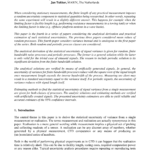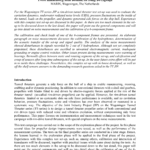





News
新JIP:海上间歇无人值守驾驶台
JOIN THE ALERT PROJECT: SAFELY LEAVING THE NAVIGATION BRIDGE UNATTENDED FOR PERIODS OF TIME WHILE AT SEA Within the new JIP initiative Alert we will determine the conditions for when it is safe to periodically leave navigation spaces unattended and at the same time examine whether that improves the safety, working and living situation for the crew […]
Events
Publications
2017

Brouwer, Joris; Tukker, Jan
Random uncertainty of variance of finite length measurement signals Conference
The 5th international conference on advanced model measurements technology (AMT '17) 11/13-10-2017, 2017.
@conference{Brouwer2017,
title = {Random uncertainty of variance of finite length measurement signals},
author = {Joris Brouwer and Jan Tukker},
url = {http://www.marin.nl/web/Publications/Publication-items/Random-uncertainty-of-variance-of-finite-length-measurement-signals.htm},
year = {2017},
date = {2017-10-11},
booktitle = {The 5th international conference on advanced model measurements technology (AMT '17) 11/13-10-2017},
abstract = {When considering stationary measurements, the finite length of any practical measurement imposes a random uncertainty component to statistical quantities being researched. In other words, repeating the same experiment will result in a slightly different answer. This happens for example when the limiting factor is facility length (e.g. performing resistance measurements in a towing tank) or when the limiting factor is time (e.g. offshore platform motions in a wave basin).
This paper is the fourth in a series of papers considering the analytical derivation and practical estimation of such statistical uncertainties. The previous three papers considered mean values of
random processes. This fourth paper considers variance instead and is analogous to the first paper of the series. Both random and periodic process classes are considered. The analytical derivation of the statistical uncertainty of signal variance is given for random, finite bandwidth noise processes and periodic processes. The former is a general solution while the latter is only valid for the trivial case of sinusoid signals. The reason to include periodic solution is its significant deviation from the finite bandwidth solution. The analytical solutions are verified by means of artificially generated signals. In general, the uncertainty of variance for finite bandwidth processes reduce with the square root of the signal length once measurement length exceeds the inverse bandwidth of the process. Measuring too short may result in a standard uncertainty equal to the variance itself. For periodic signals, the uncertainty of variance reduces with signal length itself. Estimating methods to find the statistical uncertainty of signal variance from a single measurement are given for both classes of processes. The analytic solutions and estimating methods are verified with artificially created signals. The presented uncertainty estimators are able to yield reliable and accurate estimates of the 95% confidence intervals.},
keywords = {},
pubstate = {published},
tppubtype = {conference}
}
This paper is the fourth in a series of papers considering the analytical derivation and practical estimation of such statistical uncertainties. The previous three papers considered mean values of
random processes. This fourth paper considers variance instead and is analogous to the first paper of the series. Both random and periodic process classes are considered. The analytical derivation of the statistical uncertainty of signal variance is given for random, finite bandwidth noise processes and periodic processes. The former is a general solution while the latter is only valid for the trivial case of sinusoid signals. The reason to include periodic solution is its significant deviation from the finite bandwidth solution. The analytical solutions are verified by means of artificially generated signals. In general, the uncertainty of variance for finite bandwidth processes reduce with the square root of the signal length once measurement length exceeds the inverse bandwidth of the process. Measuring too short may result in a standard uncertainty equal to the variance itself. For periodic signals, the uncertainty of variance reduces with signal length itself. Estimating methods to find the statistical uncertainty of signal variance from a single measurement are given for both classes of processes. The analytic solutions and estimating methods are verified with artificially created signals. The presented uncertainty estimators are able to yield reliable and accurate estimates of the 95% confidence intervals.

René Bosman Yvette Klinkenberg, Jie Dang; Ligtelijn, Do
Advanced measurements of rim-driven tunnel thrusters --The Wageningen TT-series JIP-- Conference
The 5th international conference on advanced model measurements technology (AMT '17) 11/13-10-2017, 2017.
@conference{Klinkenberg2017,
title = {Advanced measurements of rim-driven tunnel thrusters --The Wageningen TT-series JIP--},
author = {Yvette Klinkenberg, René Bosman, Jie Dang and Do Ligtelijn},
url = {http://www.marin.nl/web/Publications/Publication-items/Advanced-measurements-of-rimdriven-tunnel-thrusters-The-Wageningen-TTseries-JIP.htm},
year = {2017},
date = {2017-10-11},
booktitle = {The 5th international conference on advanced model measurements technology (AMT '17) 11/13-10-2017},
abstract = {For the Wageningen TT-series JIP a rim-driven tunnel thruster test set-up was used to evaluate the cavitation dynamics, underwater radiated noise levels (URN), pressure fluctuations on the inside of the tunnel, loads on the propeller, and dynamic generated side forces on the ship hull. Experiences with this complex test set-up are discussed in this paper. As there are too much elements in the set-up to be discussed down to the last detail, this paper will point out the general components and will go into detail on noise measurements and the calibration of a 6-component frame.
The calibration and check loads of one of the 6-component frames are presented. An elaborate paragraph on noise measurements discusses the calibration of the hydrophones, determination of the acoustic transfer of the set-up and signal quality. The analysis of the noise measurements showed disturbances in signals recorded by 2 out of 3 hydrophones. Although not yet completely pinpointed, these disturbances are ascribed to unwanted electromagnetic current, inadequate grounding or engine control switches. Other issues present during measurements were warming of bearings, Bernoulli effects between static and rotating segments of the set-up, and calcification and creep of sensors after long time submergence of the set-up. In the near future extra effort will be put in to tackle these challenges. Nevertheless, this complex set-up with in-house developed, as well as off the shelf sensors answers to the demanding research questions asked in the TT JIP.},
keywords = {},
pubstate = {published},
tppubtype = {conference}
}
The calibration and check loads of one of the 6-component frames are presented. An elaborate paragraph on noise measurements discusses the calibration of the hydrophones, determination of the acoustic transfer of the set-up and signal quality. The analysis of the noise measurements showed disturbances in signals recorded by 2 out of 3 hydrophones. Although not yet completely pinpointed, these disturbances are ascribed to unwanted electromagnetic current, inadequate grounding or engine control switches. Other issues present during measurements were warming of bearings, Bernoulli effects between static and rotating segments of the set-up, and calcification and creep of sensors after long time submergence of the set-up. In the near future extra effort will be put in to tackle these challenges. Nevertheless, this complex set-up with in-house developed, as well as off the shelf sensors answers to the demanding research questions asked in the TT JIP.

